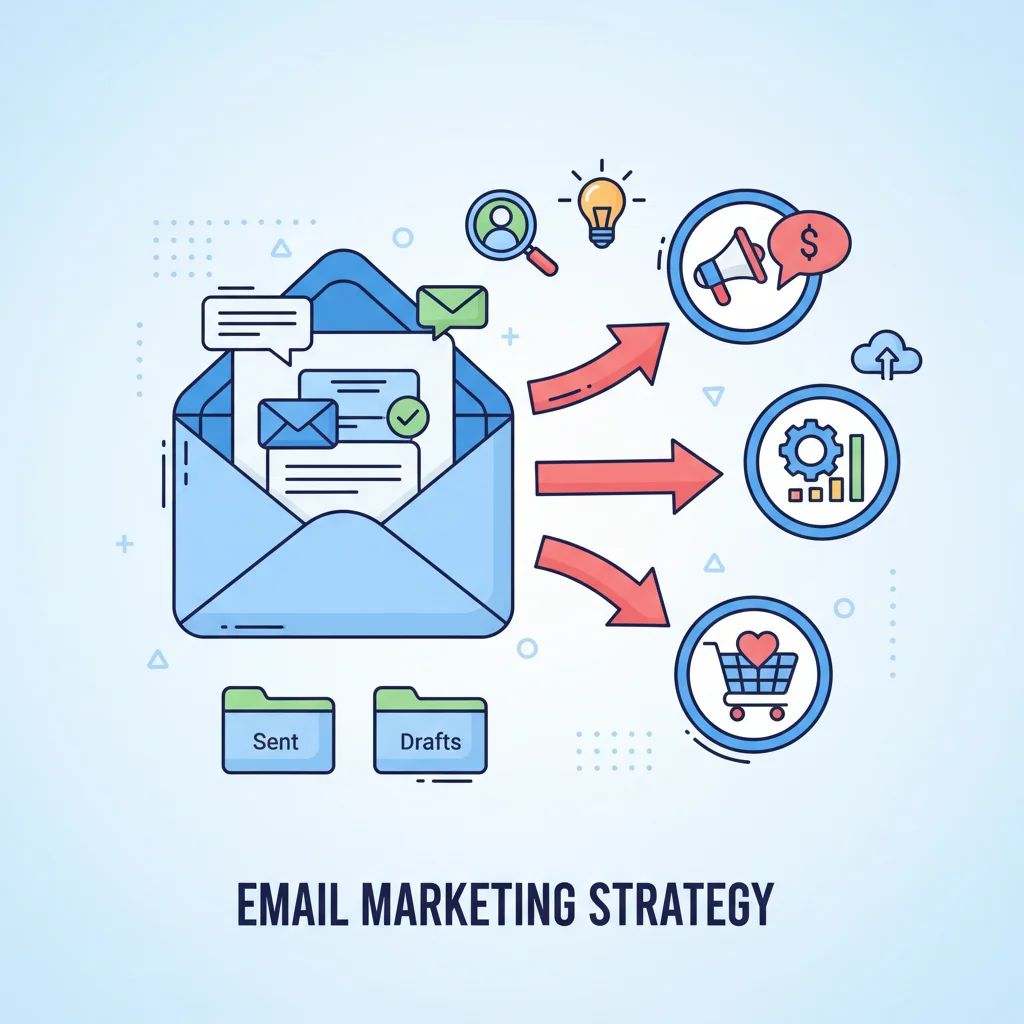Now Reading: How to Bypass Spam Filters in Email Marketing: Best Practices for Inbox Delivery
-
01
How to Bypass Spam Filters in Email Marketing: Best Practices for Inbox Delivery
How to Bypass Spam Filters in Email Marketing: Best Practices for Inbox Delivery

Email service providers like Gmail, Outlook, and Yahoo are constantly updating their algorithms to protect users from unwanted messages, making it essential to stay current with best practices for avoiding these filters.
Avoiding spam filters in email marketing best practices isn’t just about tweaking a few words – it’s about understanding the complex ecosystem of email deliverability and implementing a comprehensive strategy to ensure your messages reach their intended audience.
In this comprehensive guide, we’ll explore proven strategies to keep your marketing emails out of spam folders and in front of your subscribers’ eyes. From technical setup to content creation, we’ll cover everything you need to know about avoiding spam filters in email marketing best practices.
Key Takeaways
How do I avoid my marketing emails going to the spam folder?
- Use a reputable email service provider with a good sending reputation
- Authenticate your domain with SPF, DKIM, and DMARC protocols
- Build and maintain a clean email list with proper opt-in procedures
- Craft non-spammy content by avoiding trigger words and maintaining good text-to-image ratios
- Personalize your emails and focus on engagement metrics
- Implement proper technical configurations like warming up your IP address
- Regularly monitor your deliverability metrics and sender reputation
Understanding Email Spam Filters
Before diving into solutions, it’s crucial to understand what we’re up against. Spam filters have evolved from simple keyword scanners to sophisticated systems that analyze multiple factors to determine whether an email should reach the inbox.
How Spam Filters Work
Modern spam filters use complex algorithms that evaluate various elements of your email, including:
- Sender reputation: Your IP address and domain history
- Authentication: Whether your emails pass SPF, DKIM, and DMARC checks
- Content analysis: The words, phrases, and formatting in your emails
- Engagement metrics: How recipients interact with your emails
- Technical factors: HTML quality, image-to-text ratio, and more
These filters assign a “spam score” to each email. If that score exceeds a certain threshold, your message gets redirected to the spam folder. Understanding these mechanisms is the first step in avoiding spam filters in email marketing best practices.
Types of Spam Filters
Different email clients use various filtering systems:
- Content-based filters: Analyze the actual content of your email
- Header filters: Check the information in your email header
- Permission filters: Verify if the recipient has agreed to receive your emails
- Reputation-based filters: Assess your sending history and reputation
- Engagement filters: Evaluate how recipients interact with your messages
Now that we understand what we’re dealing with, let’s explore the best practices for avoiding these filters.
Useful Articles:
Technical Best Practice for Avoiding Spam Filters
Use a Reputable Email Service Provider
Your choice of email service provider (ESP) significantly impacts deliverability. Reputable ESPs maintain good relationships with inbox providers and implement proper infrastructure to support email deliverability.
Benefits of using a reputable ESP:
- Pre-established sender reputation
- Built-in compliance with anti-spam regulations
- Deliverability monitoring tools
- Authentication setup assistance
When selecting an ESP, look for one with a strong track record of deliverability success and robust anti-spam compliance features.
Authenticate Your Domain
Email authentication is no longer optional—it’s essential for avoiding spam filters. Implementing these protocols tells receiving servers that you are who you claim to be:
SPF (Sender Policy Framework): Specifies which mail servers are authorized to send emails on behalf of your domain.
DKIM (DomainKeys Identified Mail): Adds a digital signature to your emails that verifies they haven’t been tampered with during transit.
DMARC (Domain-based Message Authentication, Reporting & Conformance): Tells receiving servers what to do with emails that fail SPF or DKIM checks and provides reporting on authentication results.
Setting up these protocols may sound technical, but most reputable ESPs provide step-by-step guidance. For example, to set up SPF, you’ll add a TXT record to your domain’s DNS settings that looks something like:
v=spf1 include:_spf.youresp.com ~allWarm Up Your IP Address
If you’re using a new IP address or domain for sending emails, don’t immediately start sending large volumes. This behavior resembles that of spammers and can trigger filters.
Instead, gradually increase your sending volume over time:
- Week 1: Send to your most engaged subscribers (perhaps 10-20% of your list)
- Week 2: Increase to 30-40% of your list
- Week 3: Reach 60-70% of your list
- Week 4: Send to your entire list
This gradual approach helps establish a positive sending reputation with ISPs.
Maintain a Consistent Sending Schedule
Erratic sending patterns can raise red flags with spam filters. Establish a consistent sending schedule that your subscribers can anticipate. This not only helps with deliverability but also trains your audience to expect and engage with your emails.
List Management Best Practices
Build Your List Organically
One of the most important aspects of avoiding spam filters in email marketing best practices is starting with a quality list. Never purchase email lists or scrape emails from websites. These practices violate anti-spam laws and almost guarantee poor deliverability.
Instead, focus on organic list building methods:
- Website signup forms
- Lead magnets and content upgrades
- In-person event signups
- Social media campaigns
- Referral programs
Implement Double Opt-in
Double opt-in requires subscribers to confirm their subscription by clicking a link in a confirmation email. While this may reduce your initial signup numbers, it ensures that everyone on your list genuinely wants to receive your emails.
The benefits of double opt-in include:
- Higher-quality subscribers
- Improved engagement rates
- Reduced spam complaints
- Compliance with stricter regulations like GDPR
Regular List Cleaning
Even with the best acquisition practices, email lists naturally degrade over time. People change email addresses, lose interest, or simply forget they subscribed. Regular list cleaning helps maintain high deliverability rates.
How to clean your email list:
- Remove hard bounces immediately
- Address soft bounces after multiple failures
- Segment inactive subscribers (no opens or clicks for 3-6 months)
- Run a re-engagement campaign for inactives
- Remove those who don’t respond to re-engagement efforts
- Use email verification services to identify invalid addresses
Honor Unsubscribe Requests Promptly
When someone unsubscribes from your list, remove them immediately—not just because it’s the law (CAN-SPAM, GDPR, etc.), but because continuing to email uninterested recipients can lead to spam complaints that damage your sender reputation.
Make your unsubscribe process simple and straightforward. Don’t hide the unsubscribe link or make users jump through hoops to stop receiving your emails.
Useful Articles:
Content Best Practices
Avoid Spam Trigger Words
Certain words and phrases can trigger spam filters when used excessively or in particular combinations. While no single word will automatically send your email to spam, using too many high-risk terms increases your spam score.
Categories of spam trigger words to avoid:
Money and financial terms:
- Free cash
- Earn $$$
- Make money fast
- No credit check
- Eliminate debt
- 100% free
Urgency and pressure:
- Act now
- Limited time
- Last chance
- Don’t miss out
- Urgent action needed
Marketing and overpromises:
- Buy direct
- Click here
- Risk-free
- Guaranteed
- No catch
- No hidden costs
Health and pharma:
- Miracle cure
- Weight loss
- Anti-aging
- No prescription needed
Suspicious or deceptive:
- This isn’t spam
- No obligation
- Winner
- Congratulations
- Dear friend
Instead of these trigger words, focus on clear, benefit-driven language that accurately describes your offer without resorting to hype or exaggeration.
Maintain Proper Text-to-Image Ratio
Spammers often hide their text in images to avoid content-based filters. As a result, emails with too many images and little text tend to trigger spam filters.
Best practices for text-to-image ratio:
- Aim for an 80/20 text-to-image ratio
- Never send an email that’s one large image
- Include alt text for all images
- Ensure your email makes sense even with images disabled
- Limit the number of images to 3-5 per email
Craft Clear, Relevant Subject Lines
Your subject line is the first thing both recipients and spam filters evaluate. Misleading or overly promotional subject lines not only trigger spam filters but also violate anti-spam laws like CAN-SPAM.
Subject line best practices:
- Keep it under 50 characters
- Accurately reflect the email content
- Avoid ALL CAPS and excessive punctuation (!!!)
- Don’t use multiple symbols ($$, !!!, ???)
- Personalize when possible
- Test different approaches to see what resonates with your audience
Examples of good subject lines:
- “Your April newsletter: 5 tips for better sleep”
- “[Name], your order confirmation #12345”
- “New arrivals you might like based on your last purchase”
Examples of problematic subject lines:
- “OPEN NOW!!! Don’t miss this AMAZING offer!!!”
- “Make $5,000 Working From Home – Guaranteed!!!”
- “You’ve Been Selected As Our WINNER!!!”
Optimize HTML Code
Poor HTML code is a common spam trigger. If you’re using HTML emails (rather than plain text), ensure your code is clean and properly formatted.
HTML email best practices:
- Use a responsive, mobile-friendly template
- Keep your HTML code simple and clean
- Test your emails across different email clients
- Avoid JavaScript, Flash, or other complex elements
- Include a plain-text version of your email
- Test your email’s rendering before sending
Personalize Your Content
Personalization goes beyond just including the recipient’s name. True personalization means sending relevant content based on subscriber data, behavior, and preferences.
Effective personalization strategies:
- Segment your list based on interests, behavior, or demographics
- Use dynamic content that changes based on subscriber attributes
- Reference previous interactions or purchases
- Send triggered emails based on specific actions
- Tailor recommendations based on browsing or purchase history
Personalized emails not only avoid spam filters but also generate 6x higher transaction rates compared to generic messages.
Engagement Best Practices
Focus on Subscriber Engagement
Email service providers increasingly use engagement metrics to determine whether emails should go to the inbox or spam folder. If recipients consistently open, click, and interact with your emails, they’re more likely to reach the inbox.
Strategies to boost engagement:
- Send valuable, relevant content that subscribers want to read
- Ask questions and encourage replies
- Include interactive elements like polls or surveys
- Request feedback on your emails
- Segment your list to ensure relevance
- Test different sending times to find optimal engagement windows
Ask Subscribers to Whitelist You
One direct way to improve deliverability is to ask subscribers to add your email address to their contacts or safe senders list. This simple action tells their email provider that they want to receive your messages.
Include instructions in your welcome email and occasionally remind subscribers in your regular communications. For example:
“To ensure you don’t miss our emails, please add [email@yourdomain.com] to your contacts list.”
Monitor and Improve Deliverability Metrics
You can’t improve what you don’t measure. Regularly monitor key deliverability metrics to identify and address issues before they significantly impact your campaigns.
Key metrics to track:
- Delivery rate: Percentage of emails that reached recipients’ servers
- Inbox placement rate: Percentage of delivered emails that reached the inbox (not spam)
- Open rate: Percentage of delivered emails that were opened
- Click-through rate: Percentage of opened emails that generated clicks
- Spam complaint rate: Number of recipients who marked your email as spam
- Bounce rate: Percentage of emails that couldn’t be delivered
Many ESPs provide these metrics, but you can also use specialized deliverability tools for more detailed insights.
Useful Articles:
Compliance Best Practices
Follow Anti-Spam Regulations
Compliance with anti-spam laws isn’t just about avoiding legal issues—it’s also about following practices that improve deliverability. The major regulations to be aware of include:
CAN-SPAM Act (US): Requires commercial emails to include a valid physical address, clear identification as an advertisement when applicable, and an easy way to unsubscribe.
GDPR (European Union): Requires explicit consent before sending marketing emails and comprehensive privacy disclosures.
CASL (Canada): Requires express or implied consent, identification information, and an unsubscribe mechanism.
While these regulations have different requirements, following the strictest guidelines generally ensures compliance with all of them.
Include Required Elements in Every Email
To comply with regulations and avoid spam filters, include these elements in every marketing email:
- Your business name and physical address
- A clear, one-click unsubscribe option
- An explanation of why the recipient is receiving the email
- Your privacy policy
- Accurate “From” name and reply-to address
Testing and Optimization
Use Spam Testing Tools
Before sending your campaigns, run them through spam testing tools that check for potential deliverability issues. These tools analyze your content, code, and authentication to identify problems that might trigger spam filters.
Popular spam testing tools include:
- Mail-Tester
- GlockApps
- Litmus Spam Testing
- Email on Acid
A/B Test Your Emails
Regular testing helps you identify what works best for your audience and improves deliverability over time. Test different elements of your emails to see what generates the best engagement:
- Subject lines
- Preheader text
- Email design and layout
- Call-to-action buttons
- Sending times and days
- Content types and formats
Remember to test one element at a time to clearly identify what impacts your results.
Implement Feedback Loops
Feedback loops (FBLs) notify you when recipients mark your emails as spam. Most major ISPs offer FBLs that you or your ESP can sign up for. When you receive a spam complaint notification, immediately remove that email address from your list to prevent further complaints.
Troubleshooting Deliverability Issues
Identify the Problem
If you notice a sudden drop in deliverability, systematically investigate the cause:
- Check your sender reputation: Use tools like SenderScore or Talos Intelligence
- Review recent changes: New content, increased sending volume, or list additions
- Look for blacklisting: Check if your IP or domain is on any blacklists
- Analyze spam complaints: Look for patterns in who’s marking your emails as spam
- Review engagement metrics: Has engagement dropped significantly?
Implement Solutions
Once you’ve identified the issue, take appropriate action:
- Poor sender reputation: Reduce sending volume, focus on your most engaged subscribers, and gradually rebuild your reputation
- Blacklisting: Follow the delisting process for each blacklist
- Content issues: Revise problematic content and run it through spam testing tools
- Authentication problems: Fix SPF, DKIM, or DMARC configuration issues
- List quality issues: Clean your list and improve acquisition practices
Document and Learn
Keep a record of deliverability issues and solutions to prevent similar problems in the future. This documentation becomes a valuable resource for your team and helps establish a culture of deliverability best practices.
Advanced Strategies for Avoiding Spam Filters
Implement BIMI (Brand Indicators for Message Identification)
BIMI is a newer email authentication standard that allows you to display your logo next to your emails in supporting inboxes. Beyond the branding benefits, BIMI signals to email providers that you’re committed to email authentication and security.
To implement BIMI:
- Ensure you have DMARC set up with an enforcement policy
- Create a BIMI-compliant logo
- Add a BIMI DNS record
- For some providers like Gmail, obtain a Verified Mark Certificate (VMC)
Use AI and Machine Learning for Content Optimization
Advanced email marketing platforms now offer AI-powered tools that can help optimize your content for deliverability. These tools analyze your content against known spam triggers and suggest improvements before you send.
Implement Email Segmentation and Targeting
The more relevant your emails are to recipients, the more likely they are to engage—and engagement is a key factor in inbox placement. Implement sophisticated segmentation strategies:
- Behavioral segmentation based on website activity
- Purchase history segmentation
- Engagement-level segmentation
- Customer lifecycle segmentation
- Interest-based segmentation
Consider Dedicated IP Addresses
If you send high volumes of email, consider using dedicated IP addresses rather than shared IPs. With dedicated IPs, you have complete control over your sending reputation. However, this approach requires consistent sending volume and proper IP warming.
Avoiding spam filters in email marketing best practices requires a multifaceted approach that encompasses technical setup, list management, content creation, and ongoing optimization. By implementing the strategies outlined in this guide, you’ll significantly improve your chances of reaching the inbox and achieving the full potential of your email marketing efforts.





















